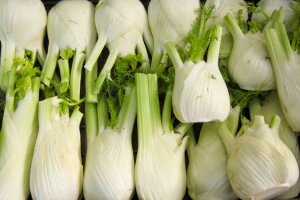These underappreciated vegetables can add variety to your meals and benefit your health. Read more about how to prepare and eat these underdogs of the produce aisle.
Most of us don’t eat nearly enough vegetables. In the United States, nine out of 10 adults fail to meet the recommended daily intake of vegetables. We also are not varying our vegetable choices enough.
Potatoes and tomatoes – mostly in the form of french fries and pizza sauce, respectively – are consistently the most-consumed vegetables for the last 20 years, according to data from the U.S. Department of Agriculture.
While it’s important to increase overall vegetable intake (2 to 4 cups per day, based on age), it’s also important to focus on hitting all five subgroups of vegetables recommended by MyPlate:
- Dark green: spinach, broccoli, arugula and collard greens.
- Red and orange: red bell peppers, carrots and butternut squash.
- Beans, peas and lentils, such as chickpeas, edamame and black beans.
- Starchy: potatoes, yams and peas.
- Other vegetables.
Mixing up your vegetable choices means you won’t be missing out on the unique bundle of nutrients and beneficial plant compounds that are found in these different subgroups. You’ll also be getting out of a veggie rut if you tend to rely on potatoes and tomatoes like so many other people.
Vegetables to Try
So, what’s considered an “other” vegetable? These are vegetables that do not fit neatly in the other four groups. They’re also under-appreciated vegetables that you’re probably overlooking in the produce aisle.
Here are six vegetables that fall in the “other” category that are worthy of your attention.
Celeriac
Also known as celery root, celeriac is the brown, bulbous ugly sister of its more popular stalky sibling. The earthy taste is like a cross between fresh celery, a potato and parsley. Behind its bumpy, dull skin is a crisp white interior that is incredibly versatile.
Native to the Mediterranean region and parts of Europe, celeriac is a vegetable I enjoyed frequently when traveling to London, including celeriac shawarma at Yotam Ottolenghi’s Rovi restaurant and celeriac steak on a bed of lentils and vegetables at The Wolseley, two excellent plant-based entrees. In France, celeriac rémoulade is a classic salad made with grated fresh celeriac in a tangy mustard and mayonnaise dressing.
Celeriac is a popular item on restaurant menus in Europe, especially in creamy soups, gratins and roasted vegetable medleys. However in the U.S., celeriac only appears on 2% of restaurant menus according to Datassential, a market research firm that tracks menu penetration of ingredients.
With about half the calories and carbohydrates compared to white potatoes, pureed celeriac is increasingly enjoyed as a lower-carb alternative to mashed potatoes. Celeriac is an excellent source of vitamins C and K and is a good source of fiber, vitamin B6, phosphorous, manganese, molybdenum and potassium.
Chayote
This green, pear-shaped gourd is a type of summer squash that originated from Central America. Chayote squash is an essential part of Mexican, Louisiana Creole and Cajun and Caribbean cuisines. In fact, that’s how registered dietitian Carolyn O’Neil, a food and travel journalist and author of The Happy Healthy Kitchen, first discovered chayote.
“That’s a tremendous part of the value of travel; it can broaden our perspectives and broaden our palates,” says O’Neil. She experienced multiple applications and numerous names of this versatile vegetable, which is called different things based on the country and cuisine, including mirliton, choko, christophene, chou chou and vegetable pear.
The mild-tasting squash soaks up the flavors around it, says O’Neil, who describes the taste as a balance between cucumber and zucchini with a jicama-like crispness. O’Neil suggests using chayote in salads, soups and salsas, or roasting it like other root vegetables.
In Mexico and Louisiana, chayotes are often stuffed like eggplant. In Puerto Rico, it is scrambled with eggs and ham. In Jamaica, chayotes are added to apple pies.
Chayote is less starchy than some squashes, with 6 grams of carbohydrates per cup. This versatile vegetable is also good source of vitamin C.
Fennel
If you’re not a fan of licorice, then you may be purposely avoiding fennel, which has a mild anise flavor. But it’s worth giving fennel another chance.
Fennel is a bulbous vegetable that originated in the Mediterranean and has been used for centuries. A flowering plant in the carrot family, fennel features a fat white bulb with long green stems and fluffy fronds. It can be eaten raw or cooked, thinly sliced to be added to salads, side dishes or main entrees.
Amy Myrdal Miller, a registered dietitian and founder of Farmer’s Daughter Consulting, loves the licorice-like flavor of fennel, which becomes more muted when cooked. She says fennel pairs beautifully with citrus. Adding thin slices of raw fennel to a citrus salad adds an interesting flavor contrast to the sweetness of citrus, Myrdal Miller says.
Myrdal Miller also sautés fennel in extra-virgin olive oil to tame the licorice flavor and bring out the sweetness of this vegetable. She included a lentil fennel lasagna recipe in her cookbook Cooking à la Heart. It’s a plant-based lasagna that she says tastes like it contains Italian sausage because of the inclusion of the fennel bulbs and seeds.
Fennel is increasingly featured on restaurant menus, served alongside fish and chicken, tossed with pasta or added to flatbreads. The vegetable is a good source of vitamin C, potassium and fiber.
Sunchokes
This knobby root vegetable is the tuber of perennial sunflowers. With its light brown, bumpy appearance, sunchokes look a bit like fresh ginger root. You’ll sometimes hear them called Jerusalem artichokes, although they look nothing like artichokes and have no apparent ties to Jerusalem.
Sunchokes do taste a little like artichokes, or similar to potatoes and water chestnuts. This hearty winter vegetable can be eaten raw or cooked the same way as other root vegetables – roasted, steamed, braised, sauteed, fried, mashed or twice-baked. Raw sunchokes can be grated or thinly sliced for topping salads.
Myrdal Miller is a big fan of sunchokes. She prefers to leave the peel on for extra fiber and ease of preparation.
“If I make a big batch of roasted sunchokes, I’ll use the leftovers to make a pureed soup for lunch the next day topped with a few snipped chives from my garden,” says Myrdal Miller.
Sunchokes are a good source of vitamin B1 and iron. They’re also one of the few natural food sources of the trendy prebiotic fiber inulin, which is increasingly used to fortify foods and beverages. Inulin fiber may be valuable for digestive health, satiety and blood sugar control.
Romanesco
Romanesco might be the showiest vegetable in the produce aisle, yet it’s still often ignored. Chartreuse in color, this cruciferous vegetable has a distinctive fractal shape with spiral-like florets. Romanesco is from the same family as broccoli and cauliflower. In fact, it’s also known as broccoflower.
Milder, sweeter and nuttier in flavor compared to broccoli and cauliflower, romanesco can be eaten raw or blanched in salads or on crudité platters. Romanesco can also be prepared in much the same ways as its cruciferous cousins: roasted, steamed, sauteed with garlic and olive oil, added to a stir-fry, tossed in pasta or risotto and baked in a quiche.
Romanesco is a good source of vitamin C, folate and fiber. As a cruciferous vegetable like broccoli, kale and chard, romanesco also contains beneficial polyphenol compounds that may help reduce the risk of certain cancers.
Purslane
Many people know purslane as a weed. It’s true, this green succulent plant sprouts in sidewalk cracks and home gardens.
While we don’t currently have the same appreciation for purslane in the U.S., it has a long history of culinary and medicinal uses in Asian and Mediterranean regions. There’s evidence that purslane was enjoyed by the ancient Romans and Greeks.
Purslane has a tart, lemony flavor with a peppery kick similar to arugula. It’s terrific in salads, which I remember enjoying during my travels to Turkey and Lebanon.
It may be more difficult to find purslane at your local supermarket, so look for it at farmer’s markets. Restaurants are increasingly serving purslane salads, including Greek restaurants. It’s also become a popular find for food foragers.
Purslane is a good source of vitamin C, vitamin A, vitamin K and magnesium. Some analyses show that purslane is higher in plant-based omega-3 fat compared to other greens – although the overall content is still rather low compared to fatty fish and other sources.
For recipe inspiration using these vegetables and more, visit Have a Plant, a resource from Produce for Better Health.



